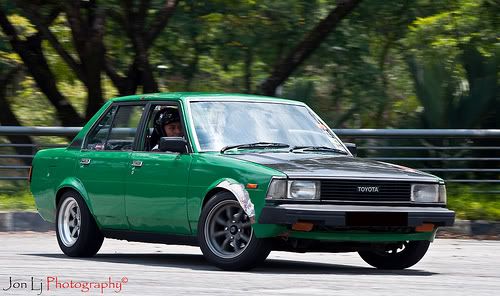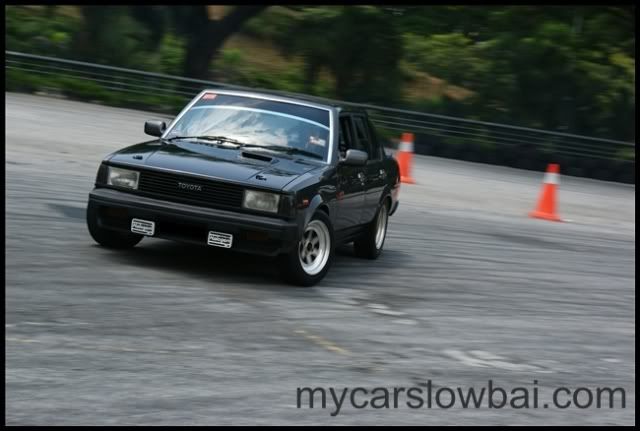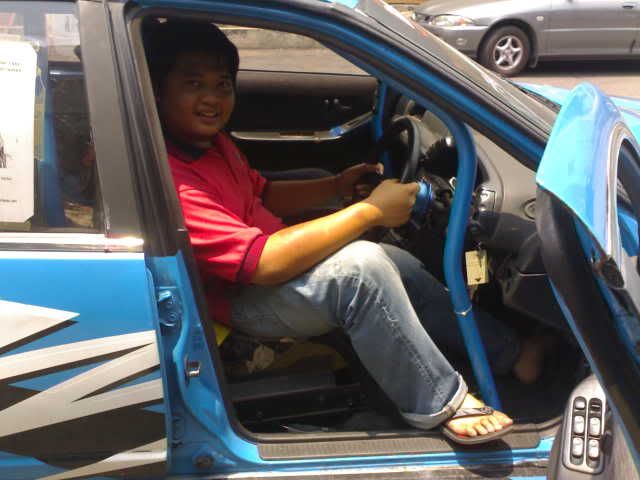The basic driving techniques used in drifting are constant, though each car and driver will employ some subset of these techniques. A similarity for all drifting techniques is to be smooth and practice. These techniques include:
Beginner techniques
These techniques do not use weight transition, so are typically the first thing the novice drifter learns. However they are still used by the most experienced drifters, and require skill to execute properly. These techniques aim to induce a loss of traction on the rear wheels, either by locking the wheel (hand brake drift) or using enough power from the engine to break the traction force (power-oversteer and clutch kick).
Hand brake drift
Hand brake is a lever that stops the rear wheel so it upsets the rear wheels grip and it tends to drift. Hand brake is one of the fastest, easiest, and dangerous for drifting. It can also damage the cars axels, stall the engine, ruin the rubber on the tires, etc. There are many ways for this not to happen but I'll show you three examples.
1st:
Come to a corner with plenty of speed like you would do in a regular grip race.
Let go of the gas, hold the clutch and pull the handbrake just enough to upset the rear end.
Gas and let go of the clutch at the same time.
Control the drift all the way.
2nd
Come to a corner with plenty of speed like you would do in a regular grip race.
Let go of the gas and pull the hand brake. to the optimum angle. Then let go.
Control the drift all the way.
3rd
Come to a corner with plenty of speed like you would do in a regular grip race but this time, 5-20 MPH slower and or if mastered, in a higher rear.
Hold the clutch and gas it just on the redline or about 6000-8300 rpm (on dial says 6-8.3 or 60-83) and hold the handbrake to the optimum angle. Then let go.
Let go of the clutch and gas it until controllable.
Control the drift all the way.
Power oversteer or Powerslide
It is usually done at the corner exit by stepping on the gas hard, to slide side ways out of the corner. It is most commonly employed by beginners because it teaches steering and throttle control without the danger of an actual entry oriented drift.
In low-power cars power oversteer can be achieved by applying excessive amount of throttle at the end of a shift. As you are releasing the clutch during a shift, or immediately before that while the clutch is still depressed, press accelerator all the way to send more power to the rear wheels than is necessary for a smooth upshift. If done during a turn, the car will begin to slide. This technique can be used to initiate a drift at very low speeds in an underpowered car (e.g., when shifting from 1st to 2nd gear), and to enter in a higher gear while accelerating all the way up to the turn (e.g., accelerate in 2nd on the straight and shift into 3rd as you enter the turn).
The sequence of actions is as follows:
Easily feather the gas in the straight line leading to the turn.
Turn the steering wheel to begin the turn.
Floor the accelerator.
Wait for the car to go sideways, then countersteer and control the slide and proceed to exit the corner.
Depending on how much power the car is making it is possible to keep the gas pedal floored from the shift throughout the entire drift, and in a low-power car this is often necessary.
Nissan 240SX Shift Lock Drifting
Shift lock (compression slide)
Initiated by downshifting (usually from third to second or fourth to third, and using a very fast shift) instead of braking, without rev-matching, causing the drive wheels to lock momentarily. Helpful for very tight corners, allowing the driver to approach the corner at a slower speed and lower revs, while allowing quick acceleration when exiting the corner. This technique can be very damaging to the engine if mis-used as the ECU is unable to rev limit when the engine is oversped by the rear wheels. Premature downshifters are called "Rod Stretchers".
Clutch Kick
This is done by "kicking" the clutch (pushing in, then out, usually more than one time in a drift for adjustment in a very fast manner) to send a shock through the powertrain, upsetting the car's balance. This causes the rear wheels to slip. The foot should be at an angle (heel-toe) so the brake and gas may be pressed as well, this being needed to control speed and stop from spinning out in the drift.
Clutch kick can also be used during a drift to gain angle at the expense of speed. If the car is about to straighten itself out, kicking the clutch will cause it to rotate more. However since power delivery is interrupted while the clutch is depressed the car will lose some speed during the process and damage the gears and crank shaft. The steps to clutch kick:
Start driving into a corner but slower, and/or in a higher gear.
Turn into the corner.
Gas and a split second later you gas, keep tapping the clutch to make the wheels spin to slide but don't let go of the gas when clutching.
Control the spin with the handbrake, brake, or gas.
(If nessesary, keep popping the clutch to keep the wheels sliding)
Weight transition techniques
These techniques employ a further concept of weight transition. When a vehicle has the load towards the front, the back wheels have less grip than the front, causing an oversteer condition that can initiate a drift.
Braking drift
This drift is performed by braking into a corner, so that the car can transfer weight to the front. This is immediately followed by throttle, which in an RWD car causes the rear wheels to lose traction. FWD cars can also use this technique as it does not depend on the rear wheels being driven. In FWD cars the front wheels are not allowed to lock due to the continuous power, the rear wheels locks easily due to weight transfer and due to the general front heavy design of FWDs. Good performance brake pads will help this technique.
Inertia (Feint) drift or Scandinavian flick
This is done by transferring the weight of the car towards the outside of a turn by first turning away from the turn and then quickly turning back using the inertia of the rear of the car to swing into the desired drifting line. Sometimes the hand-brake will be applied while transferring the weight of the car towards the outside to lock the rear wheels and help the rear swing outwards. This type of drifting causes the car to accelerate faster afterwards, because of momentum built up while drifting.
Note that the actual scandinavian flick maneuver in rally driving is more complex than feint drifting. In scandinavian flick the tires are intentionally locked by braking hard right after turning a little away from the corner. While the wheels are locked, the driver applies steering input into the corner, adds throttle while still braking and then rapidly releases the brake pedal. This causes the car to slingshot itself through the corner.
Kansei, Lift off, or Taking In
By letting off the accelerator while cornering at very high speeds, cars with relatively neutral handling will begin to slide, simply from the weight transfer resulting from engine braking. The drift is controlled afterwards by steering inputs from the driver and light pedal work, similar to the Braking drift.
Other techniques
Dirt drop
This is done by dropping the rear tires off the sealed road onto dirt, or whatever low-grip surface borders the road, to maintain or gain drift angle. Also colloquially called "Dirt Turbo".
Choku-Dori/Manji (Pendulum)
Otherwise known as over-sway, this technique is done by swaying the car's weight back and forth on straightaways, using countersteer and throttle to maintain a large angle. This is a show maneuver that usually involves many cars following the same line. The car will be drifting straight and will be drifting side to side.
Advanced Drifting Technique
This is very useful if you have mastered all the techniques of drifting and have carefuly tuned your car with your style. If you want to master this technique, you must get good tires that have grip and can be able to drift. Many profesionals upgrade their cars from 200-1000 hp but don't go over 400 hp if you are a beginner. And make sure to put enough touque because horsepower isn't everything in drifting.
What you need is to turn off your ESP (Electronic Stability Control(Equiped in many Mercedes-Benz)), TC (Traction Control)off, require a Manual Transmission with a clutch pedal and the clutch must be 2-3 plates. Also, you will need a FR, RWD, AWD (4WD) with a 0/100-20/80 torque distrubution (front/rear), ABS can be off or disabled. Stiff suspension front and back depending on your style and must be as low from the ground as possible but not too low that it scrapes the ground (50-90 mm off the ground), and you need a LSD (Limited Slip Differential). For safety, buy a racing seat with a 4 point seat belt and a 6 or 8 point roll cage. All right. On to the steps.
Kanji type 1:
Come up to a corner at a fair rate of speed like in a race track.
Push the Brakes 50 meters away from the racing line for braking but don't slam on the brakes but push it about 50%.
Feint as little as possible.
Power-over and clutch-kick all the way.
Use handbrake and clutch-kick to increase angle.
Kanji type 2:
Come up to a corner at a fair rate of speed like in a race track.
Push the Brakes 50 meters away from the racing line for braking but don't slam on the brakes but push it about 50%.
Hold the clutch and rev up to 5000-6500 RPM.
Pop the clutch and control.
Use handbrake and clutch-kick to increase angle.
If you want to transition to a different direction, hold the clutch and turn in more and clutch kick or another way is to let go of the gas, turn in, and power over and control. To end a drift is to turn in very fast and hold the clutch until steady.
Labels:
drift techniques Drift competitionat
7:20 AM Posted by DoItaLk
Drifting competitions are judged based on line, angle, speed, and show factor. Line involves taking the correct line, which is usually announced beforehand by judges. The show factor is based on multiple things, such as the amount of smoke, how close the car is to the wall, and the crowd's reaction. Angle is the angle of a car in a drift, Speed is the speed entering a turn, the speed through a turn, and the speed exiting the turn; faster is better.
Team Drift Competition in Melbourne.
The judging takes place on just a small part of the circuit, a few linking corners that provide good viewing, and opportunities for drifting. The rest of the circuit is irrelevant, except as it pertains to controlling the temperature of the tires and setting the car up for the first judged corner. In the tandem passes, the lead driver often feints his or her entry to the first corner to upset the chase driver.
There are typically two sessions, a qualifying/practice session, and a final session. In the qualifying sessions, referred as Tansou (speed run), drifters get individual passes in front of judges (who may or may not be the final judges) to try and make the final 16. This is often on the day preceding the final.
The finals are tandem passes, referred as Tsuiso (chase attack). Drivers are paired off, and each heat comprises two passes, with each driver taking a turn to lead. The best of the 8 heats go to the next 4, to the next 2, to the final. The passes are judged as explained above, however there are some provisos such as:
Overtaking the lead car under drift conditions almost always wins that pass.
Overtaking the lead car under grip conditions automatically forfeits that pass.
Spinning forfeits that pass, unless the other driver also spins.
Increasing the lead under drift conditions helps to win that pass.
Maintaining a close gap while chasing under drift conditions helps to win that pass.
Points are awarded for each pass, and usually one driver prevails. Sometimes the judges cannot agree, or cannot decide, or a crowd vocally disagrees with the judge's decision. In such cases more passes may be run until a winner is produced. Sometimes mechanical failure determines the battle's outcome, either during or preceding a heat. If a car cannot enter a tandem battle, the remaining entrant (who automatically advances) will give a solo demonstration pass. In the event of apparently close or tied runs, crowds often demonstrate their desire for another run with chants of 'one more time'.
There is some regional variation, for example in Australia, the chase car is judged on how accurately it mimics the drift of the lead car, as opposed to being judged on its own merit. Other variations of the tansou/tsuiso and the tansou only method is the multi car group judging, seen in the Drift Tengoku videos where the four car team is judged in groups.






